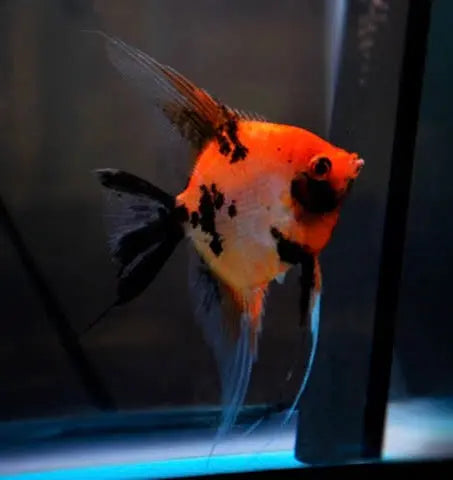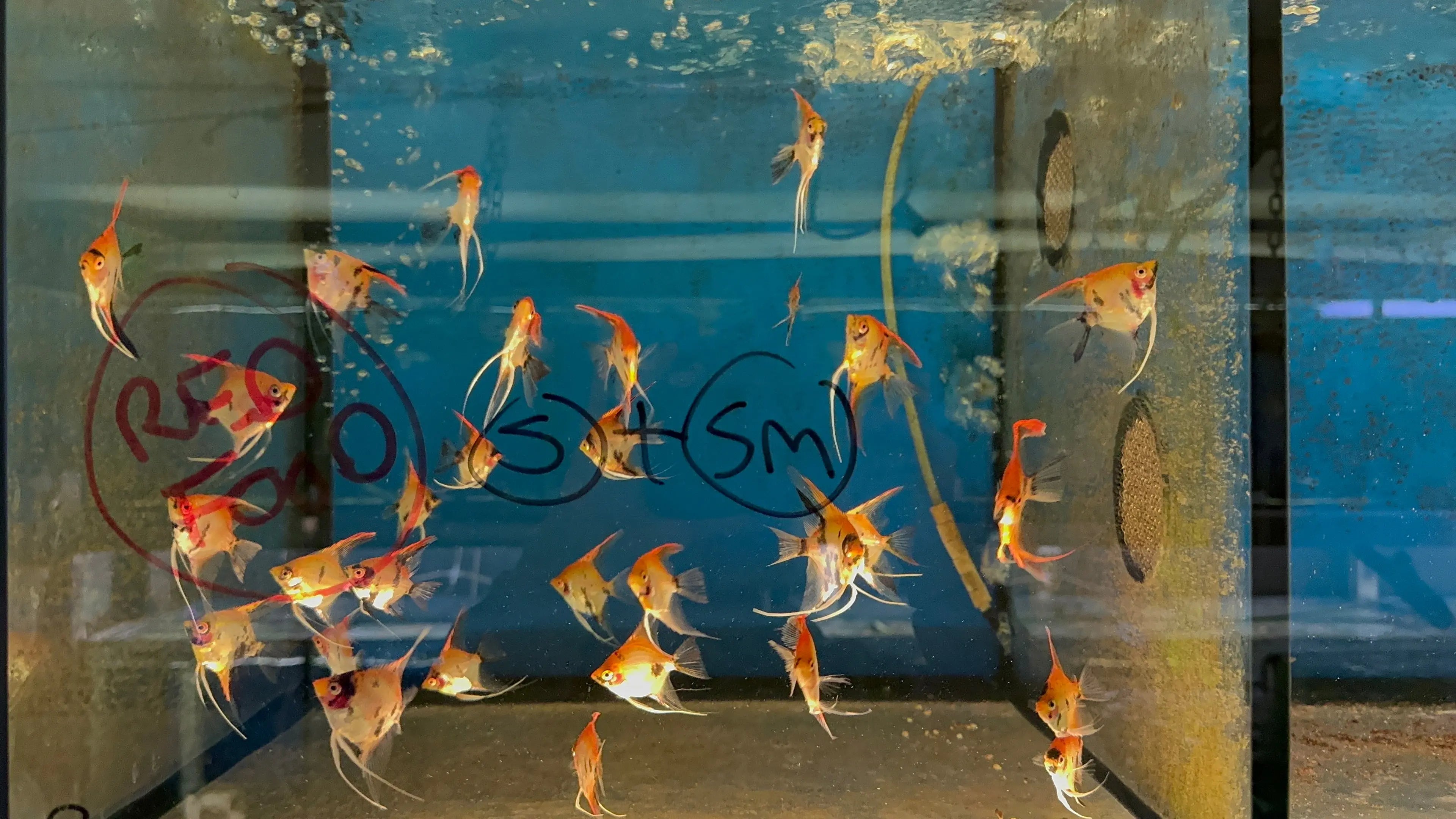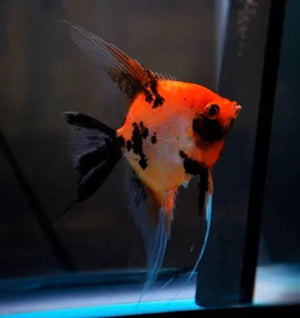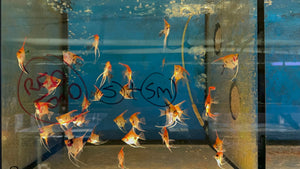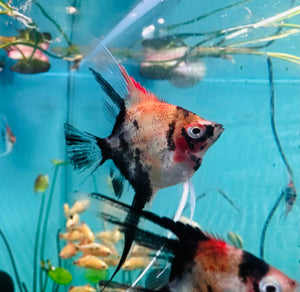Angel Fish - German Red Devil Angel Rare 5cm
Order today - receive it in as little as 3-5 days.
Return within 30 days of purchase. Duties & taxes are non-refundable.
Guarantee Safe Checkout
Red Devil Angelfish - Stunning and Aggressive Freshwater Fish for Tanks
In Australia, we love the Red Devil Angelfish for its striking looks. This freshwater fish is a real showstopper with its bright colours and bold personality. It's perfect for both new and experienced fish keepers, offering a challenge and a thrill.  The Red Devil Angelfish is a true gem in the freshwater fish world. Its deep red colours and detailed patterns are mesmerising. But, beware - its beauty comes with a price. It's fiercely territorial and aggressive, making it a challenging but rewarding fish for your tank.
The Red Devil Angelfish is a true gem in the freshwater fish world. Its deep red colours and detailed patterns are mesmerising. But, beware - its beauty comes with a price. It's fiercely territorial and aggressive, making it a challenging but rewarding fish for your tank.
Key Takeaways
- The Red Devil Angelfish is a vibrant and stunning freshwater fish with a bold, aggressive personality.
- It's a popular choice among experienced aquarium enthusiasts in Australia due to its striking appearance and challenging management requirements.
- The Red Devil Angelfish requires a well-designed tank environment and careful monitoring to ensure its health and compatibility with other tank mates.
- This fish species demands a level of dedication and expertise from its owners, making it unsuitable for beginner fish keepers.
- Proper research and preparation are essential before introducing a Red Devil Angelfish to your aquarium setup.
Understanding Red Devil Angelfish Characteristics
Red Devil Angelfish are stunning tropical fish that catch the eye of many. They have a striking look and interesting ways of behaving. Let's explore what makes these fish so special.
Physical Appearance and Size
Red Devil Angelfish are known for their bright red colour. Their tall, slender body and long fins make them look regal. They can grow up to 12 inches long, making them quite large.
Natural Habitat and Behaviour
In the wild, Red Devil Angelfish live in slow-moving rivers in Central America. They are generally calm, living in small groups and hiding in plants. But, they can get fierce when defending their space or breeding.
Lifespan and Growth Stages
- In aquariums, Red Devil Angelfish can live up to 15 years with the right care.
- Young ones are lighter in colour and rounder than adults. As they grow, they become more vibrant and slender.
Knowing about Red Devil Angelfish helps us appreciate their beauty. It also helps us make sure they are happy in their homes.
Setting Up the Perfect Tank Environment
Creating the right tank environment is key for your marine aquarium fish, like the Red Devil Angelfish. We'll show you how to set it up perfectly. The tank size is very important. Red Devil Angelfish can grow up to 12 inches long. So, a tank of at least 75 gallons is recommended. Filtration is also crucial. These saltwater fish make a lot of waste. You need a good filtration system to keep the water clean. A mix of mechanical, biological, and chemical filtration is best.
- Mechanical filtration, like a hang-on-back or canister filter, removes solid waste and debris.
- Biological filtration, such as live rock or sponge filters, helps break down harmful compounds.
- Chemical filtration, using activated carbon, removes organic compounds and discoloration.
The substrate you choose is important too. Fine sand or small gravel are good choices. They let the fish burrow and keep the tank looking natural.
| Tank Requirement | Recommendation |
| Tank Size | Minimum 75 gallons |
| Filtration | Mechanical, Biological, and Chemical |
| Substrate | Fine sand or small gravel |
| Lighting | Moderate to high intensity |
| Décor | Live rock, driftwood, and plants |
Lighting is also key. Red Devil Angelfish need moderate to high-intensity light. This helps them thrive and supports plant growth.  The tank décor should look like their natural home. Use live rock, driftwood, and plants for hiding spots and beauty. By focusing on these key points, you'll create a great home for your Red Devil Angelfish.
The tank décor should look like their natural home. Use live rock, driftwood, and plants for hiding spots and beauty. By focusing on these key points, you'll create a great home for your Red Devil Angelfish.
Red Devil Angelfish Care and Maintenance
Keeping your marine fish, coral reef fish, or reef-dwelling fish healthy is key. For the Red Devil Angelfish, focus on their diet, water quality, and health. These aspects are crucial for their well-being.
Dietary Requirements
Red Devil Angelfish are omnivorous. They eat algae, small crustaceans, and plants in the wild. In your aquarium, offer a mix of:
- High-quality flakes or pellets for angelfish
- Freeze-dried or fresh foods like brine shrimp, bloodworms, and daphnia
- Blanched veggies like spinach or zucchini now and then
Feed them several times a day, but only what they can eat in a few minutes. Avoid overfeeding to prevent water quality issues and health problems.
Water Parameters and Quality
Red Devil Angelfish needs a clean and well-maintained aquarium. The ideal conditions include:
| Parameter | Ideal Range |
| Temperature | 75-82°F (24-28°C) |
| pH | 6.8-8.0 |
| Ammonia | 0 ppm |
| Nitrites | 0 ppm |
| Nitrates | ≤20 ppm |
Regular water changes, vacuum cleaning, and a good biological filter are vital. They help keep the water perfect for your fish.
Health Monitoring and Disease Prevention
Watch your Red Devil Angelfish closely for any signs of illness. Look out for fin rot, ich (white spot disease), and skin flukes. These are common health issues.
- Fin rot: Bacterial infections cause frayed or discolored fins.
- Ich (white spot disease): A parasite causes white spots on the body and fins.
- Skin flukes: External parasites that irritate and damage the skin.
Keep your fish healthy by maintaining good water quality, quarantining new fish, and addressing health issues quickly. This proactive approach will help your Red Devil Angelfish thrive.
Compatibility and Tank Mates
The Red Devil Angelfish is a sight to behold, but their aggressive nature can be a challenge. They are territorial and may bully or harm smaller fish. Still, with the right planning, you can create a peaceful marine aquarium for them. Choosing the right tank mates for your Red Devil Angelfish is key. Look for species that are similar in size and temperament. They should be able to stand up to the fish's occasional aggression. Some good choices include:
- Other large, robust cichlid species, such as Severum or Festivum Angelfish
- Larger, peaceful community fish like Pictus Catfish or Clown Loaches
- Fast-swimming, active species like Barbs or Danios
Introduce new tank mates slowly and carefully. This lets the Red Devil Angelfish establish its territory. Adding hiding spots, plants, and visual barriers can also help prevent fights. With the right tank mates and a well-designed aquarium, the Red Devil Angelfish can thrive. They will show off their beauty and personality in a peaceful community.
Conclusion
The red devil angelfish is a stunning addition to any aquarium. They have a bold look and a lively spirit. To keep them happy, we need to create the right tank environment and feed them well.  Keeping red devil angelfish can be a bit tricky, but it's very rewarding. Their vibrant colours and lively movements make them a standout in any tank. If you want to add excitement to your aquarium, they're a great choice. If you're interested in learning more about red devil angelfish, visit Micro Aquatic Shop in Melbourne, Australia. Their team is full of knowledge. They can help you set up the perfect tank for these amazing fish.
Keeping red devil angelfish can be a bit tricky, but it's very rewarding. Their vibrant colours and lively movements make them a standout in any tank. If you want to add excitement to your aquarium, they're a great choice. If you're interested in learning more about red devil angelfish, visit Micro Aquatic Shop in Melbourne, Australia. Their team is full of knowledge. They can help you set up the perfect tank for these amazing fish.
FAQ
What is the temperament of the Red Devil Angelfish?
The Red Devil Angelfish is known for being aggressive and territorial. They can be tough to keep, especially with other fish. We suggest being careful when choosing tank mates for them.
How big do Red Devil Angelfish get?
Red Devil Angelfish can grow up to 10 inches (25 cm) long. They have a tall, angular body shape, making them stand out.
What is the ideal tank size for Red Devil Angelfish?
For a mature Red Devil Angelfish, a tank of at least 75 gallons (280 litres) is best. This size lets them swim freely and establish their territory without stressing other fish.
What kind of water conditions do Red Devil Angelfish require?
Red Devil Angelfish do well in slightly acidic to neutral water, with a pH of 6.5 to 7.5. They prefer warm temperatures between 82°F to 86°F (28°C to 30°C) and moderate water hardness. Keeping the water stable is key for their health.
What should I feed my Red Devil Angelfish?
Red Devil Angelfish are omnivores and need a varied diet. Feed them high-quality flakes, pellets, and frozen or freeze-dried foods. Occasional live foods like brine shrimp or bloodworms are also good. A varied diet is essential for their nutrition.
Are Red Devil Angelfish difficult to care for?
While Red Devil Angelfish can be challenging, they are not the hardest fish to care for. With the right tank setup, water conditions, and diet, we can keep them thriving. However, their aggressive nature means they need experienced fish keepers to manage their tank community.
| Quantity |
1 Angel Unsex |
|---|

